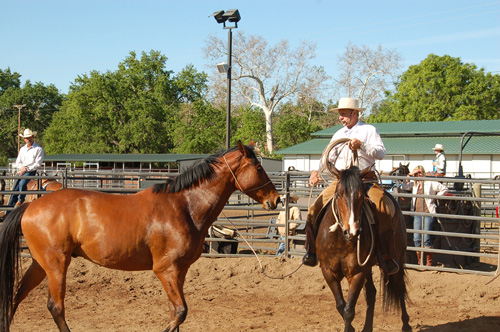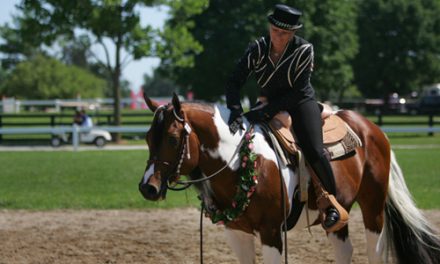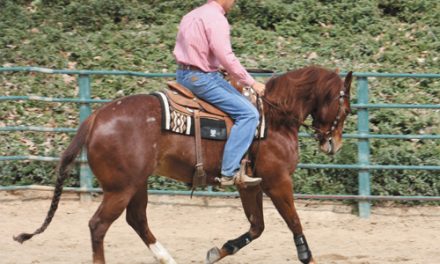 “We let our horses push us around too much,” Buck Brannaman tells us. He’s in a round pen, working with a woman’s bay colt that keeps trying to push into Buck’s space. “I would never let my horse get this bad.”
“We let our horses push us around too much,” Buck Brannaman tells us. He’s in a round pen, working with a woman’s bay colt that keeps trying to push into Buck’s space. “I would never let my horse get this bad.”
The colt’s owner, who’s standing just outside the round pen fence, calls out to Buck, “He has tantrums!”
“No he doesn’t,” Buck replies. “He doesn’t know what’s to be expected of him. Nobody ever said to this horse, ‘Hey! Get off of me!’ I’m dealing with people problems here, not horse problems.”
Buck told the woman that every time she works with her horse, she’s teaching him something. When she leads him from his stall to the round pen and he pushes her around, she’s teaching him that that behavior is OK. And when they reach the round pen and she lets go of his halter whenever he tosses his head at her, she’s teaching him to do that, too.
Buck then works with the horse. He teaches the horse to back up and come forward softly. He also keeps the horse’s nose tipped toward him so the horse can’t kick him.
The interesting thing, though, is Buck does a lot of this training from the back of his own horse. He’d earlier fashioned one end of his reatta into a halter, which he slipped over the colt’s head. He’s holding the other end of the reatta in his hand. The other tool Buck has with him is a flag, which he deftly swings or flaps to help direct the horse.
As Buck moves his own well-trained and patient horse forward and backward, the colt follows along. He says that when you get control of the horse’s feet, you get control of the horse’s mind.
Finally, the colt moves easily along with Buck and his horse. Buck hops off his horse and goes to the colt.
“No hard feelings,” he softly tells the young horse, petting him on the forehead. “It’s just the way it works.”
I’m at a clinic that Buck Brannaman is holding at Saddlecreek Ranch in Butte Valley, CA. It’s the third time I’ve been to one of his clinics, which are hosted by local trainers, Tina and Dan Gunter (see below). The morning sessions for the four-day clinic are for colt-starting. The afternoon sessions are for horsemanship.
You’d think that with the economy being in such a sorry state, the attendance at Buck’s clinic would be low. Not so. Both sessions are full! There are also a number of auditors like me who’ve come to watch and learn from the sidelines.
Why do I keep coming back? I particularly like the matter-of-fact directness Buck uses with people. It’s similar to the directness he uses with the horses. He’s clear. You never wonder what he means.
I also love watching Buck work. I never know what sort of mental or physical training tool he’ll pull out of his enormous storehouse of horse knowledge. Sometimes he’ll work from his own horse’s back, as he did with the bay colt. Other times, he’ll be on the ground, right next to a horse, or he’ll climb aboard someone’s horse and work with him that way. And then there are times when he’ll step aside and watch someone work with a horse, and offer the person advice and help from the sidelines as needed. It just all depends upon the situation.
“I’m probably not that talented,” he notes, “but I’m relentless. You just have to keep at it to get the proper training done.”
Buck was raised around horses and was an accomplished trick roper, even appearing with his brother Bill in TV commercials as the Sugar Pops Kids. It wasn’t an easy childhood, though, as he — in his typical matter-of-fact style — explains in his excellent memoir, “Those Faraway Horses.”
Fortunately for Buck, though, while still in his teens, he came in contact with Tom Dorrance and Ray Hunt, who had an enormous influence on him. Buck will often say, “If it looks good, I got it from Tom Dorrance and Ray Hunt. If it looks bad, I did it.”
At the clinic, Buck has finished with the bay colt. After that, we watch him help other people with their colts in the round pen. With one particularly fiery and troublesome stud colt, Buck ropes the horse’s back leg to help calm him. It is only when the stallion is finally lying down in the dirt that there is a hint of softness in the horse’s troubled eyes.
We break for lunch, and then the afternoon horsemanship session begins. Forty riders and their horses gather around Buck in a large arena. The riders take turns asking Buck questions or telling about issues they’re having with their mounts.
Next, Buck has the riders do a specific groundwork exercise with their horses. They bend the horse’s front end in a partial circle and then the back end. Buck goes around and helps people.
When the riders mount up after the groundwork exercise, Buck offers them pointers:
“Put the ball of your foot in the stirrup.”
“Wrap your leg around the horse; look like you belong there!”
“Don’t roll your knees in. Your toes should be turned out just enough so you have contact just behind the inner seam of your pants.”
Buck also talks about three different seat positions riders can use. In the first position, the pelvis is rocked forward. In the second position, the pelvis is straight. In the third, the pelvis is tipped back so you’re sitting on your pockets. This is the position you’d be in to stop your horse.
I look at my watch and see that it’s more than an hour past the time I need to leave. I fold up my chair, sling my camera over my shoulder, and walk to my car. It’s a lucky thing I don’t trip because the whole time, I’m watching Buck over my shoulder.
As I drive off down the road, I think of something that Buck had said that morning about a particularly-busy colt: “He’s busier than a one-legged man in a butt-kicking contest.” Ha! I can hardly wait to see Buck again next year!
Buck Brannaman quotes:
“Like Tom Dorrance said, ‘It boiled down to one thing: observe, remember, and compare.’ Do something, observe what you did, remember what you did, compare it to what you were doing before, and adjust.”
“I like a horse to walk out. I’d rather dig post holes than ride a slow-moving pig of a horse.”
“Horses are consistent and logical. The horse will do what is easiest for him. If you make it easy for him to buck you off, kick you, and run away, that’s just what he’s going to do. And more power to him. But if you make it easy for the horse to be relaxed and calm and accurate — and also have it be a beautiful dance between you and the horse — it won’t be too long before he’ll be hunting for that just as hard as you are. Whatever you make easy for the horse, that’s what he’s going to get good at.”
“I’m just trying to get people to understand horses. You have to be consistent and logical, use your brain, and not be emotional and not lose your temper.”
“I’m going to have to borrow what my friend Ray Hunt said for years, and that is, ‘I don’t know where I’m going, but I’m not lost.’”
Did you know?
Buck Brannaman was a consultant for Nicholas Evans, who wrote the best-selling novel, “The Horse Whisperer.” Buck was also a technical advisor for Robert Redford, who directed the movie of the same name. Buck even appears in the movie, and so do some of his own horses; Pet played Pilgrim and Rambo was Rimrock.
Clinic Hosts
Working quietly behind the scenes at the clinic is Tina Gunter, who along with her husband Dan hosted the clinic for Buck. Tina met Buck in the 1980s when she started attending his clinics to get help retraining off-the-track race horses to be hunters. She stayed in touch with Buck over the years and rode with him whenever she could. In 2005, while attending one of his clinics in Santa Ynez, CA, Tina made arrangements with Buck to come to Butte Valley, CA to put on a clinic at Saddlecreek Ranch. Since then, he’s been coming back each year. Tina says the clinics are always full.
“I learned early on from Buck what needed to be in place before I swung a leg over a horse,” Tina tells me. “It was always about timing and feel and keeping your horse soft, light, and responsive. He’s a great person — very humble. I’m honored to host his clinics.”
Why are they filming Buck?
During the clinic, I noticed that a film crew was videoing Buck. I spoke with Cindy Meehl, Executive Producer of Cedar Creek Productions, LLC, who is doing the filming. She said she decided to do this documentary because she felt the world needed to know about Buck. “This film,” she says, “is the only way I could think of to pass his wisdom along to a wider audience and get people interested in really helping their horses.” She says the film will be out in 2010.
Learn more about Buck Brannaman at www.brannaman.com.





